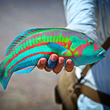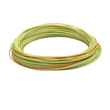I am an unabashed wild trout snob. And I'm not alone. Many others would also proudly proclaim themselves to be so because, put simply, wild trout are better in every way than their stocked counterpart. Wild trout are typically stronger, faster, more wily, more feisty and often considerably more beautiful. Stocked trout, on the other hand, so often underwhelm. As strangers to the environment they've found themselves planted in, having been raised in a tank and fed with pellets, they behave unnaturally, rarely present us with challenges and teach us little that will allow us to become better anglers. They bore us with their snubbed noses and tattered fins. And so wild trout snobs like myself seek out waters where wild trout predominate. For those of us that live in the east, this often comes often at the expense of convenience, fish size or both. But it's worth it.
Yet, despite my disdain for stocked trout, I have a soft spot for holdovers, those ill-equipped transplants that beat the odds by leveraging instinct and likely more than a bit of luck to persist through the winter and cement themselves as full fledged residents of the waters they swim in.
Even in big, bug-rich tailwaters, stocked trout that make it through a full year to greet the bucket loads of their brethren that get dumped in come spring earn a measure of respect. Regardless of the plentiful food supply and abundance of good lies, these holdovers have still defied their likely fate. In unwelcoming, icy mountain freestoners like one I recently fished — where the food supply is scarce even in the height of summer — holdover trout inspire a significant amount of awe.





























